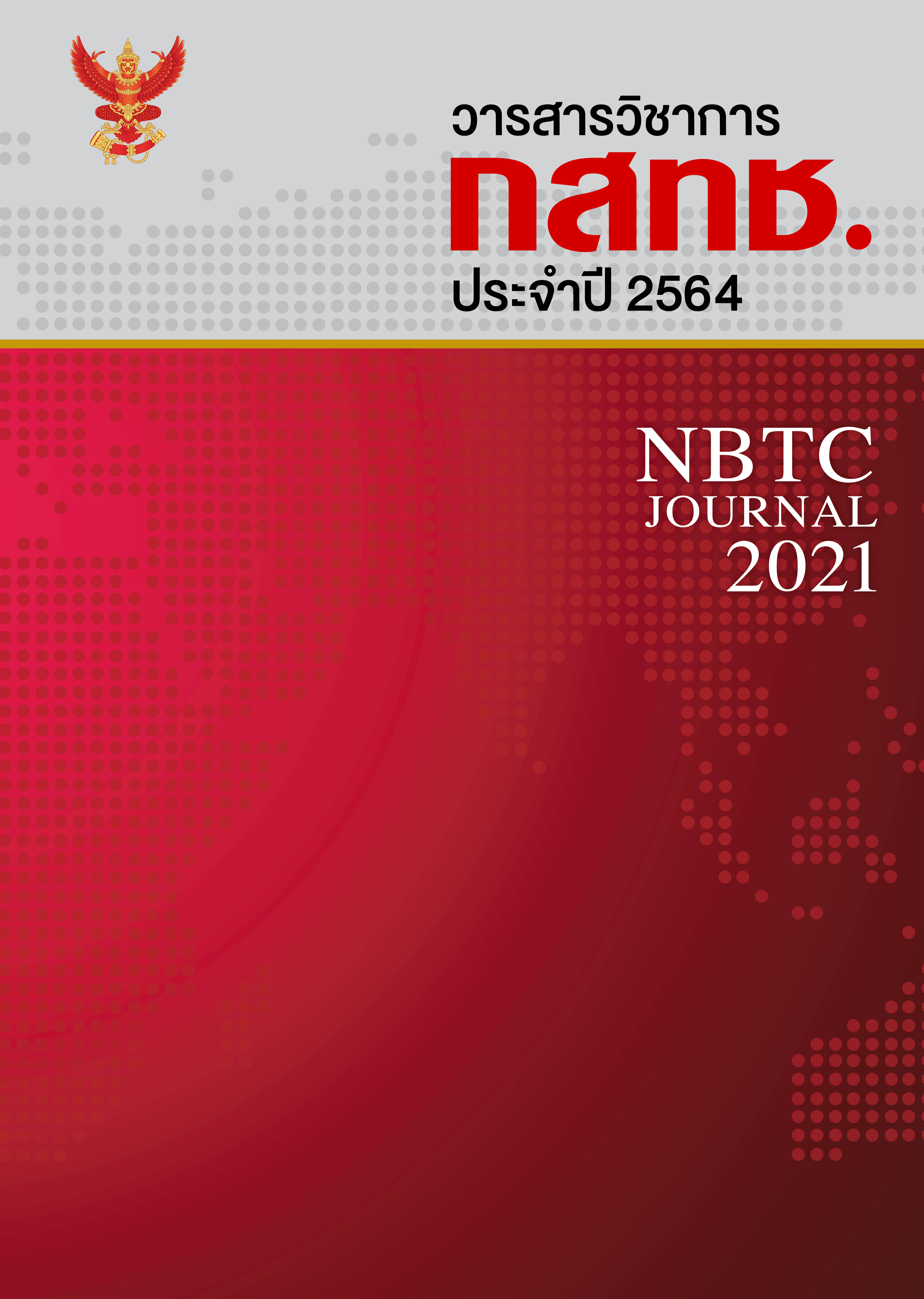Digital Etiquette: Online Communication Rules for Thai Digital Citizens Awareness
Keywords:
Digital etiquette, Netiquette, Social etiquette, Online communicationAbstract
This article researches the issue of digital etiquette, principally based on the concepts of social and internet code of conduct and interpersonal communication. Documentary research was done with data gathered from documents, books, research papers, and related articles from seven main sources. Data were analyzed by data classification and comparison, including content analysis. Results were that information on digital etiquette may be categorized into four main classifications: communication etiquette, social online etiquette, digital etiquette and violations of online behavior rules and their effect. Online communication etiquette requirements were linked to social etiquette in Thailand and abroad, communication code of conduct, and digital rules of deportment, forming the basis for online protocol today. Digital etiquette emphasizes the principle of digital empathy while reflecting the communicative nature of Internauts netizens, especially in terms of chat behavioral requirements. These findings suggest that knowledge and awareness should be promoted of digital communication etiquette in Thailand by associating it with different mechanisms to meet appropriate online social norms.
References
จุลนี เทียนไทย, ภัทรพรรณ ทำดี, ภาสนันทน์ อัศวรักษ์, ปุณณฑรีย์ เจียวิริยบุญญา, ฉันท์ฉาย ฉันทวิลาสวงศ์ และ ฐิตินันทน์ ผิวนิล. (2563). รายงานการวิจัยฉบับสมบูรณ์ การสร้างความเข้าใจในคุณลักษณะ พฤติกรรม และทัศนคติในอนาคตของชาวดิจิทัลไทย. สำนักงานการวิจัยแห่งชาติ (วช.).
นวรัตน์ คุปตานนท์. (2541). การพัฒนามารยาทเครือข่ายของผู้ใช้อินเทอร์เน็ต. [วิทยานิพนธ์ครุศาสตรมหาบัณฑิต]. จุฬาลงกรณ์มหาวิทยาลัย.
ปราวีณยา สุวรรณณัฐโชติ. (2561). วัคซีนคุ้มภัยคนยุคดิจิทัล: ประเด็นจริยธรรมและข้อควรรู้ทางกฎหมาย. ศูนย์ส่งเสริมการพัฒนานวัตกรรม ตำราและเอกสารทางวิชาการ คณะครุศาสตร์ จุฬาลงกรณ์มหาวิทยาลัย.
พิรงรอง รามสูต. (2557). การกำกับดูแลเนื้อหาอินเทอร์เน็ต. ศูนย์ศึกษานโยบายสื่อ คณะนิเทศศาสตร์ จุฬาลงกรณ์มหาวิทยาลัย.
มาร์ติน, อลิซาเบท. (2545). Good Housekeeping Everyday Etiquette [มารยาทสากล]. สถาบันการแปลหนังสือ กรมวิชาการ กระทรวงศึกษาธิการ.
มูลนิธิยุวพัฒน์. (2562). การกลั่นแกล้ง (Bullying) ความรุนแรงในสังคม. มูลนิธิยุวพัฒน์. https://www.yuvabadhanafoundation.org/ข่าวสาร/บทความทั่วไป/การกลั่นแกล้ง-bullying-วัยรุ่น/.
มูลนิธิส่งเสริมสื่อเด็กและเยาวชน. (2562). ทักษะการเอาใจเขามาใส่ใจเราทางดิจิทัล (Digital Empathy). บริษัท วอล์ค ออน คลาวด์ จำกัด.
มูลนิธิสถาบันวิจัยเพื่อการพัฒนาประเทศไทย. (2559). รายงานผลการศึกษาฉบับสมบูรณ์ (Final Report) โครงการศึกษาวิจัยการปฏิรูปสื่อ เล่มที่ 5 “การกำกับดูแลเนื้อหาของสื่อใหม่ (New Media)”. สถาบันวิจัยเพื่อการพัฒนาประเทศไทย (ทีดีอาร์ไอ). https://tdri.or.th/wp-content/uploads/2017/10/เล่มที่-5-การกำกับดูแลเนื้อหา-สื่อใหม่.pdf.
ลือรัตน์ อนุรัตน์พานิช. (2559). เจนเอ็กซ์ เจนวาย เจนแซด คืออะไร. คณะเภสัชศาสตร์ มหาวิทยาลัยมหิดล. http://www.pharmacy.mahidol.ac.th/th/knowledge/article/330.
วนิดา จันทรุจิรากร. (2543). อินเตอร์เน็ต : มิติใหม่ของการสื่อสาร. เธิร์ดเวฟ เอ็ดดูเคชั่น.
ศรีดา ตันทะอธิพานิช. (2544). ท่องอินเทอร์เน็ตอย่างปลอดภัยและได้ประโยชน์ ข้อคิดสำหรับผู้ปกครองและเยาวชน. ศูนย์เทคโนโลยีอิเล็กทรอนิกส์และคอมพิวเตอร์แห่งชาติ.
สถาบันเทคโนโลยีสารสนเทศและการสื่อสารเพื่ออุตสาหกรรม. (ม.ป.ป.) Social Network เข้ายึดพื้นที่ในโลกการสื่อสารปัจจุบัน. สถาบันเทคโนโลยีสารสนเทศและการสื่อสารเพื่ออุตสาหกรรม. http://www.icti.or.th/article_detail.aspx?id=4.
สฤณี อาชวานันทกุล. (2552). กฎหลักของมารยาทเน็ต – เอกสารประกอบการเสวนา “กติกาพลเมืองชาวเน็ต”. เครือข่ายพลเมืองเน็ต มูลนิธิเพื่ออินเทอร์เน็ตและวัฒนธรรมพลเมือง. https://thainetizen.org/docs/the-core-rules-of-netiquette/.
สำนักงานบริหารและพัฒนาองค์ความรู้ (องค์การมหาชน). (2559). 9 ข้อควรปฏิบัติของพลเมืองดิจิทัลยุคใหม่. สำนักงานบริหารและพัฒนาองค์ความรู้ (องค์การมหาชน). http://www.okmd.or.th/okmd-opportunity/digital-age/258/.
สำนักวัฒนธรรม กีฬา และการท่องเที่ยว กรุงเทพมหานคร. (2551). มารยาทไทย : มรดกทางวัฒนธรรมไทย. สำนักวัฒนธรรม กีฬา และการท่องเที่ยว กรุงเทพมหานคร.
Abulibdeh, E. S. A. (2019). UAE Undergraduate Student Digital Etiquette and Belief-Oriented TechnologyUSE: An Exploratory Survey. International Journal of Web-Based Learning and Teaching Technologies (IJWLTT), 14(1), 84-92.
Arouri, Y. M., & Hamaidi, D. A. (2017). Undergraduate students’ perspectives of the extent of practicing netiquettes in a Jordanian southern university. International Journal of Emerging Technologies in Learning (iJET), 12(03), 84-97.
Boyd, D. (2014). It's complicated: The social lives of networked teens. Yale University Press.
Hoover, J., Johnson, K., Boghrati, R., Graham, J., & Dehghani, M. (2018). Moral framing and charitable donation: Integrating exploratory social media analyses and confirmatory experimentation.Collabra: Psychology, 4(1), 9. https://doi.org/10.1525/collabra.129
Kim, E., Iyer, R., Graham, J., Chang, Y. H., & Maheswaran, R. (2013). Moral values from simple game play. In International Conference on Social Computing, Behavioral-Cultural Modeling, and Prediction (pp. 56-64). Springer, Berlin, Heidelberg.
Kumazaki, A., Suzuki, K., Katsura, R., Sakamoto, A., & Kashibuchi, M. (2011). The effects of netiquette and ICT skills on school-bullying and cyber-bullying: The two-wave panel study of Japanese elementary, secondary, and high school students. Procedia-Social and Behavioral Sciences, 29(2011), 735-741. https://doi.org/10.1016/j.sbspro.2011.11.299
Lewin-Jones, J., & Mason, V. (2014). Understanding style, language and etiquette in email communication in higher education: a survey. Research in Post-Compulsory Education, 19(1), 75-90. https://doi.org/10.1080/13596748.2014.872934
Messenger from Facebook, & Debrett's. (2019). The Art of Digital Messaging: A Guide to Communication in the Digital Age. Facebook. https://messengernews.fb.com/wp-content/uploads/2019/09/The-Art-of-Digital-Messaging_A-Guide-to-Communication-in-the-Digital-Age.pdf
Miller, D., Costa, E., Haynes, N., McDonald, T., Nicolescu, R., Sinanan,J., Spyey, J., Venkatraman, S., & Wang, X. (2016). How the world changed social media. OAPEN Library. http://library.oapen.org/handle/20.500.12657/32834.
Mooijman, M., Hoover, J., Lin, Y., Ji, H., & Dehghani, M. (2018). Moralization in social networks and the emergence of violence during protests. Nature human behaviour, 2(6), 389-396. https://doi.org/10.1038/s41562-018-0353-0.
O'Keeffe, G. S., & Clarke-Pearson, K. (2011). The impact of social media on children, adolescents, and families. Pediatrics, 127(4), 800-804. https://doi.org/10.1542/peds.2011-0054.
Park, S., Na, E. Y., & Kim, E. M. (2014). The relationship between online activities, netiquette and cyberbullying. Children and youth services review, 42, 74-81. https://doi.org/10.1016/j.childyouth.2014.04.002
Rost, K., Stahel, L., & Frey, B. S. (2016). Digital Social Norm Enforcement: Online Firestorms in Social Media. PLoS ONE, 11(6), 1-26. https://doi.org/10.1371/journal.pone.0155923
Shea, V. (1994). Core Rules of Netiquette. Educom Review, 29(5), 58-62. Albion. http://www.albion.com/netiquette/corerules.html
Shea, V., & Shea, C. (1994). Netiquette. Albion Books.
Thainthai, C. (2009). Chapter Four A Glance into the Life of a Computerized Generation: A Case Study on Thai Teenagers Living in Bangkok. In Computing and Philosophy in Asia (pp. 48-70). Cambridge Scholars Publishing.
Thianthai, C. (2018). What does social media have to do with health? A case study of Bangkok youths. International journal of adolescent medicine and health, https://doi.org/10.1515/ijamh-2018-0058.
Downloads
Published
How to Cite
Issue
Section
License
The Office of the NBTC holds the copyright of articles appearing in the journal. The Office of the NBTC allows the public or individuals to distribute, copy, or republish the work under a Creative Commons license (CC), with attribution (BY), No Derivatives (ND) and NonCommercial (NC); unless written permission is received from the Office of the NBTC.
Text, tables, and figures that appear in articles accepted for publication in this journal are personal opinion and responsibility of the author, and not binding on the NBTC and the Office of the NBTC. In case of errors, each author is solely responsible for their own article, and not concerning the NBTC and the NBTC Office in any way.



